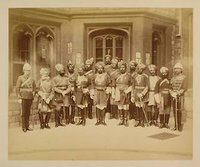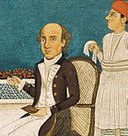A Tale of Two Cities
Without historical footing, we see Bangalore as a single sprawling city that grows in all compass directions with no natural boundary of lake, river or mountain range to stop it. However, for those who have lived here for years….there are two Bangalores.

Our first history lesson came on our Bangalore Walk about two weeks ago. We assembled at Holy Trinity Church. We walked from the front entrance of the church onto M.G. Road, following the incline of the gently sloping topography until we reached East Parade Church. Without knowing it at the time, we had walked the very ground the English had occupied when they claimed Bangalore as their Southern Indian outpost in the opening years of the 1800’s.
There is much European history tied to the strategic movement of the English troops. An American colony has been lost not too long ago, a French revolution and British – Franco wars were swirling about and costing lots of money. England was losing face as well as territory, and th
 eir finances were being strained.
eir finances were being strained.Trade was a critical element of the empire on which the sun never set. Much was afoot in the world as the 19th century dawned. Bangaluru was the one of the last sure places to have a stronghold in this flattening world of the 1800’s.
The British arrived from their established colony of Madras (now Chennai) in the eastern neighboring state of Tamil Nadu. When the British arrived to set up camp in Bangaluru, they Anglicized
 the name. They also brought with them an entourage of Tamils who had been their personal servants, nannies, barbers, blacksmiths, horse handlers, leather merchants, chiefs, cooks and bottle washers. The British set up camp, built homes and churches and became a city unto themselves knows as the British Cantonment.
the name. They also brought with them an entourage of Tamils who had been their personal servants, nannies, barbers, blacksmiths, horse handlers, leather merchants, chiefs, cooks and bottle washers. The British set up camp, built homes and churches and became a city unto themselves knows as the British Cantonment. But Bangalore was not an occupied space in the 1800’s. Not too far from where the British were setting up house
But Bangalore was not an occupied space in the 1800’s. Not too far from where the British were setting up house was a thriving community of Kannada-speaking merchants and traders. Essentially, during the beginning of the 19th century, Bangalore became a twin city, with the residents who were predominantly Kannadigas to the west and the Bangalore Cantonment, whose residents were mostly migrants from Tamil Nadu
was a thriving community of Kannada-speaking merchants and traders. Essentially, during the beginning of the 19th century, Bangalore became a twin city, with the residents who were predominantly Kannadigas to the west and the Bangalore Cantonment, whose residents were mostly migrants from Tamil Nadu  and British troops, to the east. The modern day dividing line between these communities is Cubbon Park.
and British troops, to the east. The modern day dividing line between these communities is Cubbon Park.On our Bangalore Walk, our guide Arun indicated that in his formative years in Bangalore in the 1960’s and 70’s, people living on the east side in the old British Cantonment and those in the western pete would not mingle, much like many places in America during the same time period. People have different histories, depending on their geographical location in Bangalore.
When Bangalore burned last week, it burned in the old pete, to the west of Cubbon Park. When the IT and BPO employees leave their offices and head home, most never venture beyond the now sprawling eastern cantonment. And Charles Dickens thought he had a yarn to spin.

1 Comments:
ur blog is excellent.nice blogging........
Post a Comment
<< Home